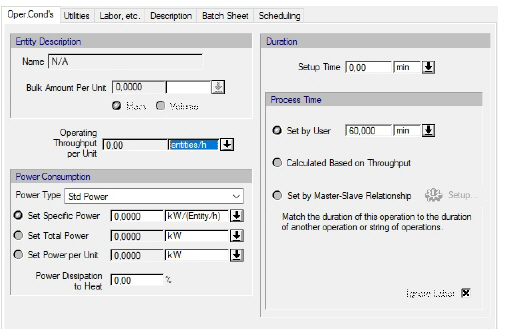

The following table shows a brief description of the variables appearing in this tab. The table also displays their default values and their generally acceptable range:
|
Variable |
Default Value |
Range |
|
|
||
|
● Entity Name |
N/A |
Any Text |
|
● Bulk Amount Per Unit (g or mL) |
0.0 |
Positive |
|
● Operating Throughput per Unit (entities/h) |
0.0 |
Positive |
|
○ Power Type |
<Std Power> |
Any Power Type |
|
◙ Specific Power (kW/(Entity/h)) |
0.0 |
Positive |
|
◙ Total Power (kW) |
0.0 |
Positive |
|
◙ Power Per Unit (kW) |
0.0 |
Positive |
|
○ Power Dissipation to Heat (%) |
0.0 |
[0,100] |
|
○ Setup Time |
0.0 |
Positive |
|
◙ Process Time |
60.0 |
Positive |
|
○ Ignore Labor? |
Yes |
Yes/No |
Symbol Key: ○ User-specified value (always input); ● Calculated value (always output); ◙ Sometimes input, sometimes output
All the variables on this tab are output and cannot be edited by the user; for more details on how these are calculated, see Discrete-to-Bulk Conversion: Modeling Calculations.